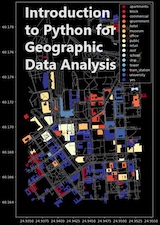
|
FreeComputerBooks.com
Links to Free Computer, Mathematics, Technical Books all over the World
|
|
- Title: Introduction to Python for Geographic Data Analysis
- Author(s) Henrikki Tenkanen, Vuokko Heikinheimo, David Whipp
- Publisher: Python GIS; eBook (Creative Commons Licensed)
- License(s): CC BY-NC 4.0
- Paperback: N/A
- eBook: HTML
- Language: English
- ISBN-10: N/A
- ISBN-13: N/A
- Share This:

|
This book introduces the basics of Python programming and geographic data analysis for all “geo-minded” people (geographers, geologists and others using spatial data). You'll learn how to apply Python GIS geospatial processes to a variety of problems, and work with remote sensing data.
About the Authors- Henrikki Tenkanen is an Assistant Professor of Geoinformation Technology at the Department of Built Environment, Aalto University (Finland).
- Python Programming
- Geographic Information Systems (GIS), Web Mapping, and GPS
- Data Analysis and Data Mining, Big Data
- Statistics, Mathematical Statistics, and SAS Programming

- Introduction to Python for Geographic Data Analysis (Henrikki Tenkanen, et al.)
- The Mirror Site (1) - HTML
- Python Geospatial Analysis Cookbook (Michael Diener) - PDF
-
 Geospatial Analysis with Python (Ujaval Gandhi)
Geospatial Analysis with Python (Ujaval Gandhi)
Suitable for GIS practitioners with no programming background or python knowledge. The course will introduce basic Python programming concepts, libraries for spatial analysis, geospatial APIs and techniques for building spatial data processing pipelines.
-
 Geographic Data Science with Python (Sergio Rey, et al.)
Geographic Data Science with Python (Sergio Rey, et al.)
Provides the tools, the methods, and the theory to meet the challenges of contemporary data science applied to geographic problems and data, by using geographical and computational reasoning to unlock new insights hidden within data.
-
 Python Scripting for Spatial Data Processing (Pete Bunting, et al)
Python Scripting for Spatial Data Processing (Pete Bunting, et al)
This book is a Python tutorial for beginners aiming at teaching spatial data processing. It is used as part of the courses taught in Remote Sensing and GIS, using psycopg2, and ogr2ogr, etc., at Aberystwyth University, UK.
-
 Geographic Data Science with R: Visualizing and Analyzing
Geographic Data Science with R: Visualizing and Analyzing
This book provides a series of tutorials aimed at teaching good practices for using Time Series and geospatial data to address topics related to environmental change. It is based on the R language and aims at data scientists.
-
 R for Geographic Data Science (Stefano De Sabbata)
R for Geographic Data Science (Stefano De Sabbata)
This book introduces readers to tools in the R programming language for accessing and analyzing Census data from the United States Census Bureau and shows how to carry out demographic analyses in a single computing environment.
-
 Spatial Data Science: With Applications in R (Edzer Pebesma, et al)
Spatial Data Science: With Applications in R (Edzer Pebesma, et al)
Introduces and explains the concepts underlying Spatial Data, gives a detailed explanation of the core spatial software packages for R: sf for simple feature access, and stars for raster and vector data cubes – array data with spatial and temporal dimensions.
-
 Geospatial Analysis: Principles, Techniques and Software Tools
Geospatial Analysis: Principles, Techniques and Software Tools
This book provides a compehensive guide to concepts, methods and tools, with many examples being provided using a variety of software tools such as ArcGIS, Idrisi, Grass, Surfer and many others to clarify the concepts discussed
-
 Spatial Thinking in Planning Practice: An Introduction to GIS
Spatial Thinking in Planning Practice: An Introduction to GIS
The goals of this textbook are to help students acquire the technical skills of using software and managing a database, and develop research skills of collecting data, analyzing information and presenting results.
-
 A Practical Guide to Geostatistical Mapping (Tomislav Hengl)
A Practical Guide to Geostatistical Mapping (Tomislav Hengl)
This book is a practical guide to geostatistical mapping using R+gstat/geoR, SAGA GIS and Google Earth combo of software packages. Includes seven diverse data analysis exercises.
-
 Python for Everybody: Exploring Data in Python 3
Python for Everybody: Exploring Data in Python 3
This book is designed to introduce students to programming and software development through the lens of exploring data. You can think of the Python programming language as your tool to solve data problems that are beyond the capability of a spreadsheet.
-
 O'Reilly® Python Data Science Handbook: Essential Tools
O'Reilly® Python Data Science Handbook: Essential Tools
Several resources exist for individual pieces of this data science stack, but only with the Python Data Science Handbook do you get them all - IPython, NumPy, Pandas, Matplotlib, Scikit-Learn, and other related tools.
-
 Nature of Geographic Information Systems (David DiBiase)
Nature of Geographic Information Systems (David DiBiase)
The purpose of this book is to promote understanding of the Geographic Information Science and Technology enterprise (GIS&T, also known as 'geospatial'). It explores the nature of geographic information.
-
 An Introductory Textbook on Geographic Information Systems
An Introductory Textbook on Geographic Information Systems
This textbook is an introduction to GIS, but most of the chapter's concepts are also applicable to other geotechnologies including remote sensing, global positioning systems (GPS), Internet mapping, and virtual globes.
-
 Geographic Information System Basics (Jonathan Campbell)
Geographic Information System Basics (Jonathan Campbell)
From the melting of the polar ice caps to privacy issues associated with mapping, this book provides a gentle, yet substantive, introduction to the use and application of digital maps, mapping, and GIS.
-
 Principles of Geographic Information Systems (GIS)
Principles of Geographic Information Systems (GIS)
This book is designed to provide students in a first or second GIS course with a solid foundation in both GIS concepts and the use of GIS. It strikes a careful balance between GIS concepts and hands-on applications.





